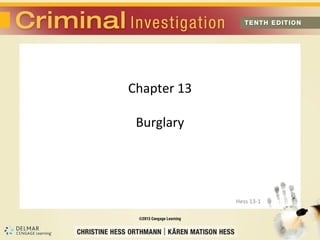
Chapter 13
- 1. Chapter 13 Burglary Hess 13-1
- 2. Introduction • Word burglar comes from the German words burg, meaning “house,” and laron, meaning “thief” • Burglary is reported by frequency and by the value of the property stolen and recovered • 30-year decline in burglaries due partly to improvements in locks and burglar alarm technology • Public regards burglary as a major crime problem Hess 13-2
- 3. Burglary versus Robbery DIFFERENCES • Burglar seeks to avoid contact • Robbers confront their victims directly • Burglary is a crime against property • Robbery is a crime against a person Hess 13-3
- 4. Classification RESIDENTIAL BURGLARIES • Buildings, structures or attachments suitable for dwellings • Routine-activity theory Likely or motivated offenders Suitable targets Absence of guardians Hess 13-4
- 5. Classification COMMERCIAL BURGLARIES • Burglars often specialize in one type of facility • Out-of-way businesses more susceptible • Occur when establishments are closed • Buildings may be “cased” in advance Hess 13-5
- 6. Elements of the Crime: Burglary KEY ELEMENTS • All states include three key elements: Entering a structure Without the consent of the person in possession With intent to commit a crime therein Hess 13-6
- 7. Elements of the Crime: Burglary ADDITIONAL ELEMENTS • Breaking into the dwelling of another during the nighttime • Presumptive evidence • Burden of proof on the defendant Hess 13-7
- 8. Establishing the Severity of the Burglary DETERMINATION • National Crime Information Center (NCIC) • Presence of dangerous devices in the burglar’s possession • Value of the property stolen • Additional crime is separate and must be proven separately Hess 13-8
- 9. Elements of the Crime: Possession of Burglary Tools ELEMENTS • An offense separate from burglary TOOLS • Nitroglycerin or other explosives • Slam pullers • Bump key • Lock bumping Hess 13-9
- 10. The Burglar REPRESENTATION • No set image • Of all sizes, ages, races and occupations • Either amateurs or longtime professionals • Most burglars’ motives are monetary or drug related Hess 13-10
- 11. Responding to a Burglary Call RESPONSE • Proceed to a burglary scene quietly • Be observant and cautious • Search the premises inside and outside FALSE BURGLAR ALARMS • Verified response policy Hess 10-11
- 12. The Preliminary Investigation OVERVIEW • National clearance rate of less than 13 percent • Perceived as being high-time investments • Low-result rewards • Show concern for victims • Log articles with serial numbers into NCIC Hess 13-12
- 13. The Preliminary Investigation RESIDENTIAL BURGLARIES • Middle- to upper-class preferred • Corner homes • See people approaching from a maximum of directions • May knock on doors • May call in advance Hess 13-13
- 14. The Preliminary Investigation COMMERCIAL BURGLARIES • Contact the owner • Protect the scene • Establish the point and method of entry and exit • Determine the type and amount of loss • Determine who closed the establishment • Describe the MO Hess 13-14
- 15. The Preliminary Investigation FAKE BURGLARIES • Especially in commercial burglaries • Owner appears to be in financial difficulty • Check the owner’s financial status • Combination safe jobs Hess 13-15
- 16. Determining Entry into Structures OVERVIEW • Burglary is a crime of opportunity and concealment • Entry is made in areas of a structure not normally observed • Jimmying • Hit-and-run burglary • Smash and grab Hess 13-16
- 17. Determining Entry into Safes and Vaults METHODS • Punching • Peeling • Chopping • Pulling or dragging • Blowing • Burning Hess 13-17
- 18. Obtaining Physical Evidence COMMON PHYSICAL EVIDENCE • Fingerprints and footprints • Tire prints, tools and tool marks • Broken glass and paint chips • Safe insulation • Explosives residue • Personal possessions Hess 13-18
- 19. Modus Operandi Factors IMPORTANCE • Time • Type of victim • Type of premises • Point and means of entry • Type of property taken • Peculiarities of the offense Hess 13-19
- 20. Effective Case Management OVERVIEW • Profiling • Mapping • Computer’s search capabilities • Recognize the mobility of burglars • Make assignments on the MO Hess 13-20
- 21. Recovering Stolen Property LEADS FOR RECOVERY • Pawnshops • Secondhand stores • Flea markets • Online auction sites • Informants Hess 13-21
- 22. Offense of Receiving Stolen Goods STOLEN PROPERTY • Fence is a go-between who receives stolen goods • Elements Receiving, buying or concealing stolen or illegally obtained goods Knowing them to be stolen Knowing them to be illegally obtained Hess 13-22
- 23. Preventing Burglary MEASURES • Installing adequate locks, striker plates and door frames • Installing adequate lighting • Providing clearly visible addresses • Eliminating obstructions to windows • Securing skylights Continued Hess 13-23
- 24. Preventing Burglary (Continued) MEASURES • Installing burglarproof sidelight window glass • Installing burglar alarm • Placing exterior burglar alarm signage • Keeping dogs on premises Hess 13-24
- 25. Summary • Burglary is the unlawful entry of a structure to commit a crime • Burglars are covert, seeking to remain unseen • Burglaries are classified as residential or commercial • When responding to a burglary call, proceed to the scene quietly Hess 13-25
